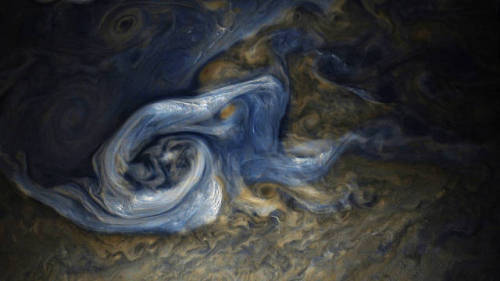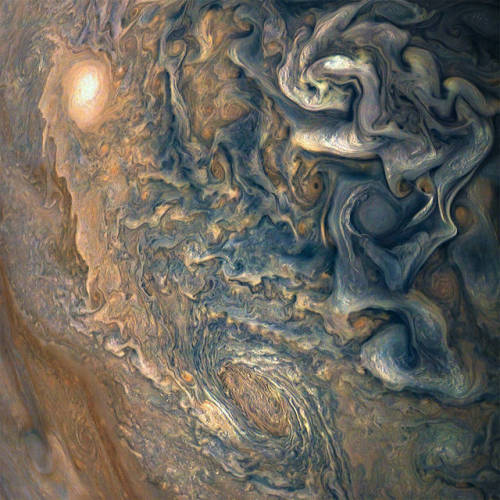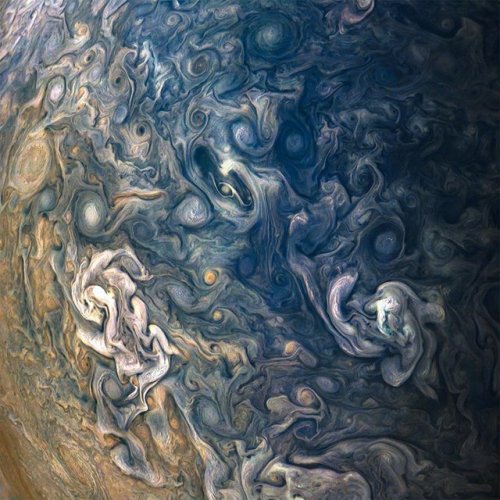.
.
More Posts from Sciencebloggin and Others

The Infrared Universe - NASA’s Spitzer Space Telescope
NASA’s Spitzer Space Telescope celebrated its 12th anniversary with the release of a new digital calendar showcasing some of the best pictures taken by the telescope. The images above demonstrate the Spitzer space telescope’s amazing infrared imaging abilities. These images include Nebulae, Galaxies, Super Nova, and much more. Though the calendar is now outdated, it still has a lot of great science information (and cool images). Check the credit for links!
Credit: NASA/JPL
I’m glad that Indiana finally has its first national park and that it’s the one mostly known for having sand dunes that eat children.










Some crazy laced agate under the microscope….🔬

Image of Saturn taken by Cassini spacecraft in October 28, 2016.
Credit: NASA/JPL






Swirls of Jupiter
Jupiter is a very stormy, turbulent, violent planet. The planet completes a day (or one complete rotation) within roughly 10 hours, which creates massive winds, producing these swirls, and violent storms. The fast rotation coupled with the fact that the planet is nothing but gas greatly multiplies the Coriolis effect. Earth too has a Coriolis effect, this creates the characteristic hurricane shapes and also contributes to the fact that storms will spin the opposite direction in different hemispheres. Luckily, our rotation is slower - our storms are less frequent and less violent than they would be if our days were shorter.
The above images come from the recent Juno mission by NASA.
Traditional chinese craftsmanship for architecture and furniture 榫卯 sǔn mǎo
The mortise and tenon technique does not use glues or nails and creates furniture that is usually very strong and durable.
Astronaut tweets



























Fata Morgna
A Superior Mirage that comes from the Italian term named after the Arthurian sorceress Morgan le Fay, from a belief that these mirages, often seen in the Strait of Messina, were fairy castles in the air or false land created by her witchcraft to lure sailors to their deaths. It’s also believed that this illusion caused the myth of The Flying Dutchman to emerge.

Pulling apart duct tape causes chemical bonds to break which indirectly gives rise to a faint blue glow in an effect called triboluminescence



dude.
-
 herehaveafandom liked this · 1 week ago
herehaveafandom liked this · 1 week ago -
 fungicult reblogged this · 1 week ago
fungicult reblogged this · 1 week ago -
 moonbeam-rising liked this · 3 weeks ago
moonbeam-rising liked this · 3 weeks ago -
 cheesecakeapologist liked this · 3 weeks ago
cheesecakeapologist liked this · 3 weeks ago -
 the-hopeless-fanboy liked this · 3 weeks ago
the-hopeless-fanboy liked this · 3 weeks ago -
 rukathetransformer liked this · 3 weeks ago
rukathetransformer liked this · 3 weeks ago -
 eye-searing reblogged this · 3 weeks ago
eye-searing reblogged this · 3 weeks ago -
 goldnugget28 liked this · 3 weeks ago
goldnugget28 liked this · 3 weeks ago -
 ka-pustka liked this · 3 weeks ago
ka-pustka liked this · 3 weeks ago -
 zapsoda reblogged this · 3 weeks ago
zapsoda reblogged this · 3 weeks ago -
 fataltrip liked this · 3 weeks ago
fataltrip liked this · 3 weeks ago -
 1x4s liked this · 3 weeks ago
1x4s liked this · 3 weeks ago -
 tf2-hrt reblogged this · 3 weeks ago
tf2-hrt reblogged this · 3 weeks ago -
 tf2-hrt liked this · 3 weeks ago
tf2-hrt liked this · 3 weeks ago -
 battery-enthusiast reblogged this · 3 weeks ago
battery-enthusiast reblogged this · 3 weeks ago -
 battery-enthusiast liked this · 3 weeks ago
battery-enthusiast liked this · 3 weeks ago -
 isowizard-handler-of-suggestions reblogged this · 3 weeks ago
isowizard-handler-of-suggestions reblogged this · 3 weeks ago -
 dredgen-dumbass liked this · 1 month ago
dredgen-dumbass liked this · 1 month ago -
 mintbecrazy reblogged this · 1 month ago
mintbecrazy reblogged this · 1 month ago -
 mintbecrazy liked this · 1 month ago
mintbecrazy liked this · 1 month ago -
 lucilia-citrine reblogged this · 1 month ago
lucilia-citrine reblogged this · 1 month ago -
 lucilia-citrine liked this · 1 month ago
lucilia-citrine liked this · 1 month ago -
 valk-3 reblogged this · 1 month ago
valk-3 reblogged this · 1 month ago -
 patientstriderart liked this · 1 month ago
patientstriderart liked this · 1 month ago -
 bloomingphases reblogged this · 1 month ago
bloomingphases reblogged this · 1 month ago -
 bloomingphases liked this · 1 month ago
bloomingphases liked this · 1 month ago -
 the-casual-cat reblogged this · 1 month ago
the-casual-cat reblogged this · 1 month ago -
 axolotlmage47 liked this · 1 month ago
axolotlmage47 liked this · 1 month ago -
 charmanderxerneas liked this · 1 month ago
charmanderxerneas liked this · 1 month ago -
 tignya reblogged this · 1 month ago
tignya reblogged this · 1 month ago -
 administer-distractions reblogged this · 1 month ago
administer-distractions reblogged this · 1 month ago -
 system32error reblogged this · 1 month ago
system32error reblogged this · 1 month ago -
 system32error liked this · 1 month ago
system32error liked this · 1 month ago -
 macbutchpro reblogged this · 1 month ago
macbutchpro reblogged this · 1 month ago -
 macbutchpro liked this · 1 month ago
macbutchpro liked this · 1 month ago -
 seerya liked this · 1 month ago
seerya liked this · 1 month ago -
 beckab liked this · 1 month ago
beckab liked this · 1 month ago -
 nannyoggskitchen reblogged this · 1 month ago
nannyoggskitchen reblogged this · 1 month ago -
 nannyoggskitchen liked this · 1 month ago
nannyoggskitchen liked this · 1 month ago -
 captainsugaraddict reblogged this · 1 month ago
captainsugaraddict reblogged this · 1 month ago -
 captainsugaraddict liked this · 1 month ago
captainsugaraddict liked this · 1 month ago -
 vampyrtrain reblogged this · 1 month ago
vampyrtrain reblogged this · 1 month ago -
 kaddeycat liked this · 1 month ago
kaddeycat liked this · 1 month ago -
 nbbaern reblogged this · 1 month ago
nbbaern reblogged this · 1 month ago -
 coolfenouil liked this · 1 month ago
coolfenouil liked this · 1 month ago -
 smute reblogged this · 1 month ago
smute reblogged this · 1 month ago -
 l0ztgh0zt reblogged this · 1 month ago
l0ztgh0zt reblogged this · 1 month ago -
 l0ztgh0zt liked this · 1 month ago
l0ztgh0zt liked this · 1 month ago
